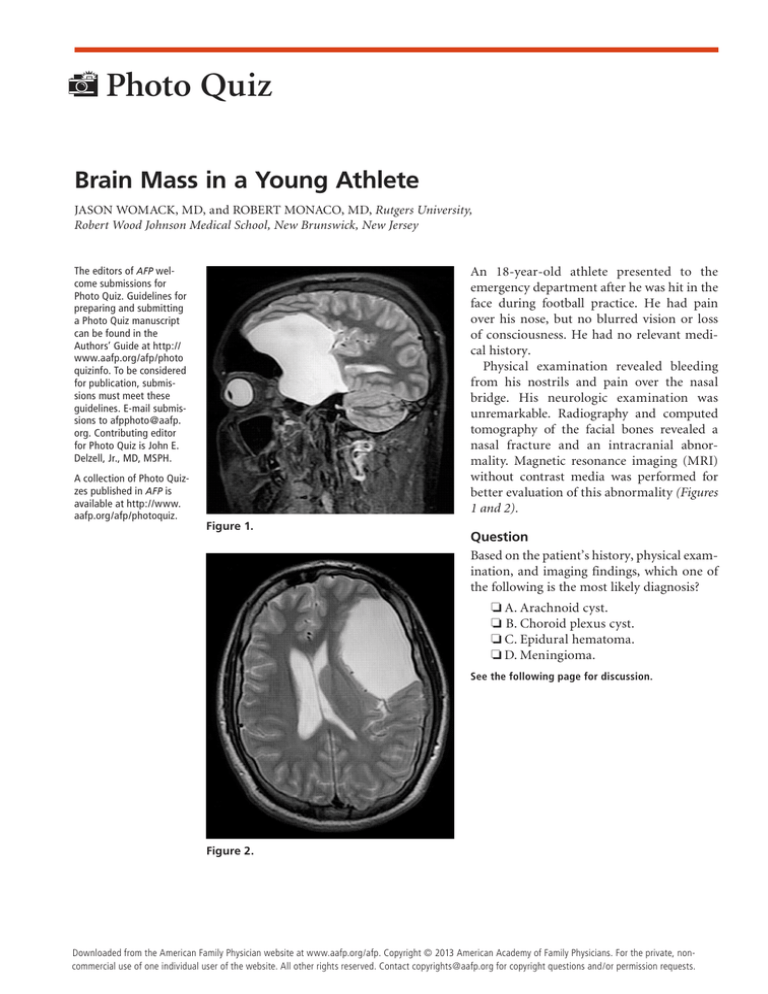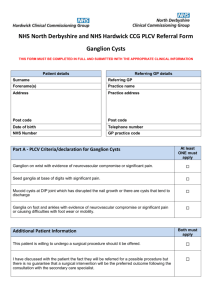
Photo Quiz
Brain Mass in a Young Athlete
JASON WOMACK, MD, and ROBERT MONACO, MD, Rutgers University,
Robert Wood Johnson Medical School, New Brunswick, New Jersey
The editors of AFP welcome submissions for
Photo Quiz. Guidelines for
preparing and submitting
a Photo Quiz manuscript
can be found in the
Authors’ Guide at http://
www.aafp.org/afp/photo
quizinfo. To be considered
for publication, submissions must meet these
guidelines. E-mail submissions to afpphoto@aafp.
org. Contributing editor
for Photo Quiz is John E.
Delzell, Jr., MD, MSPH.
A collection of Photo Quizzes published in AFP is
available at http://www.
aafp.org/afp/photoquiz.
An 18-year-old athlete presented to the
emergency department after he was hit in the
face during football practice. He had pain
over his nose, but no blurred vision or loss
of consciousness. He had no relevant medical history.
Physical examination revealed bleeding
from his nostrils and pain over the nasal
bridge. His neurologic examination was
unremarkable. Radiography and computed
tomography of the facial bones revealed a
nasal fracture and an intracranial abnormality. Magnetic resonance imaging (MRI)
without contrast media was performed for
better evaluation of this abnormality (Figures
1 and 2).
Figure 1.
Question
Based on the patient’s history, physical examination, and imaging findings, which one of
the following is the most likely diagnosis?
❏ A. Arachnoid cyst.
❏ B. Choroid plexus cyst.
❏ C. Epidural hematoma.
❏ D. Meningioma.
See the following page for discussion.
Figure 2.
◆ Volume 88, Number 12
December 15,
www.aafp.org/afp
American Academy of Family
American
825
Downloaded
from2013
the American
Family Physician website at www.aafp.org/afp.
Copyright © 2013
Physicians.Family
For thePhysician
private, noncommercial use of one individual user of the website. All other rights reserved. Contact copyrights@aafp.org for copyright questions and/or permission requests.
Photo Quiz
Discussion
The answer is A: arachnoid cyst. Arachnoid
cysts are congenital intracranial lesions that
are thought to develop from splitting or
duplication of the arachnoid membrane during development.1 They represent 1% to 2%
of all intracranial lesions.2 Most arachnoid
cysts are asymptomatic and are discovered
incidentally during an unrelated evaluation.
Symptomatic arachnoid cysts cause a mass
effect on the brain, and headache is the most
common symptom.3
Arachnoid cysts are filled with cerebrospinal fluid (CSF); therefore, the signal intensity on MRI is identical to that of CSF
elsewhere in the brain. The cysts have homogeneous signal intensity, do not have internal architecture, and do not enhance with
contrast media. They are sharply demarcated. Arachnoid cysts may increase the
risk of intracranial bleeding while playing
contact sports. Indications for surgery are
symptoms from significant mass effect on
Summary Table
Characteristics
Arachnoid cyst
Often an incidental finding because most are
asymptomatic; same signal intensity on MRI as CSF
Usually seen in the lateral ventricles; hyperintense on
MRI compared with CSF
Causes rapid alteration of mental status after head
trauma; biconvex appearance, not the same signal
intensity on MRI as CSF
Heterogeneous signal uptake on MRI because
of intersubstance matter, which may consist of
calcifications, hemorrhage, cysts, or vascularity
Meningioma
REFERENCES
CSF = cerebrospinal fluid; MRI = magnetic resonance imaging.
826 American Family Physician
Address correspondence to Jason Womack, MD, at
jason.womack@rutgers.edu. Reprints are not available
from the authors.
Author disclosure: No relevant financial affiliations.
Condition
Choroid plexus
cyst
Epidural
hematoma
the adjacent brain causing distorted gyral
pattern or midline shift.4
Choroid plexus cysts are common intracranial cysts, usually on the choroid plexus
of the lateral ventricles. The cysts are hyperintense compared with CSF on MRI, and
they enhance with contrast media.
An epidural hematoma is a rapidly enlarging arterial bleed between the inner skull
and the dura from trauma. It often causes
rapid neurologic decline and has a biconvex
shape, as opposed to the scalloped appearance of an arachnoid cyst.5 The blood of an
epidural hematoma does not have the same
signal intensity of CSF.
Meningiomas are benign tumors of the
dura mater. MRI findings typically include
a heterogeneous signal uptake because
these tumors have a large amount of intersubstance matter. This matter may consist of calcifications, hemorrhage, cysts, or
vascularity.
1.Osborn AG, Preece MT. Intracranial cysts: radiologicpathologic correlation and imaging approach. Radiology. 2006;239(3):650-664.
2.Weber F, Knopf H. Incidental findings in magnetic
resonance imaging of the brains of healthy young men.
J Neurol Sci. 2006;240(1-2):81-84.
3.Vigil DV, DiFiori JP, Puffer JC, Peacock WJ. Arachnoid
cyst and subdural hygroma in a high school football
player. Clin J Sport Med. 1998;8(3):234-237.
4.Gamradt SC, Brophy R, Barnes R, et al. Incidental findings in cerebral imaging: arachnoid cyst in a professional
football player. Clin J Sport Med. 2008;18(1):97-99.
5.Le TH, Gean AD. Neuroimaging of traumatic brain
injury. Mt Sinai J Med. 2009;76(2):145-162. ■
www.aafp.org/afp
Volume 88, Number 12
◆
December 15, 2013



